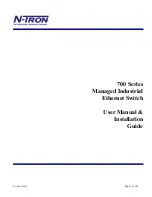
3Com Switch 8800 Configuration Guide
Chapter 38 MSTP Region-configuration
38-32
Operation
Command
Configure TC protection of the switch (from
system view)
stp tc-protection enable
Disable TC protection (from system view)
stp
tc-protection disable
By default, only the protection from TC-BPDU packet attack is enabled on the switch.
BPDU protection, Root protection and loop protection are disabled.
After configured with BPDU protection, the switch will disable the edge port through
MSTP which receives a BPDU, and notify the network manager at same time. These
ports can be resumed by the network manager only.
The port configured with Root protection only plays a role of designated port on every
instance. Whenever such port receives a higher-priority BPDU, that is, it is about to turn
into non-designated port, it will be set to listening state and not forward packets any
more (as if the link to the port is disconnected). If the port has not received any
higher-priority BPDU for a certain period of time thereafter, it will resume the normal
state.
For one port, only one configuration can be effective among loop protection, Root
protection and Edge port configuration at the same moment.
Note:
The port configured with loop protection can only turn into discarding state on every
instance. That such a port receives no configuration message for a long time indicates
that it is about to change its state and role. Only the port role changes but the port
discarding state remains unchanged, and no packets are forwarded. In this way, if the
peer end cannot send BPDU packets due to error operation, and the port enters
forwarding state directly for not receiving configuration message for a long time, no loop
will be generated by enabling the loop protection.
By default, the switch does not enable BPDU protection or Root protection.
38.2.17 Enabling/Disabling MSTP on the Device
You can use the following command to enable MSTP on the device.
Perform the following configuration in system view.
















































